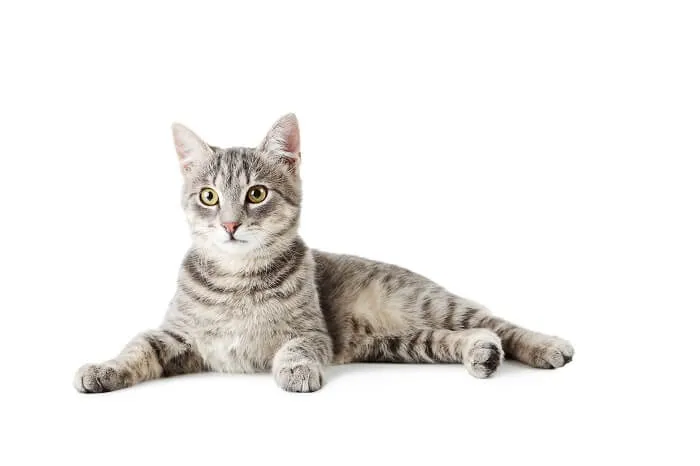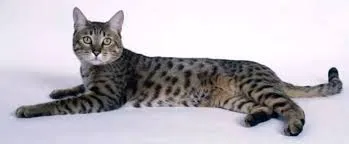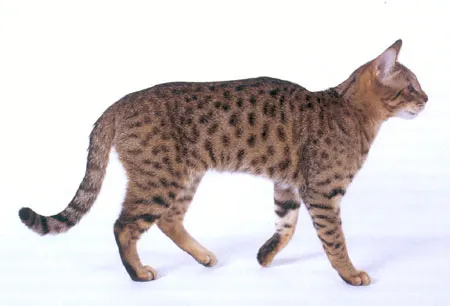The California Spangled Cat, often called the “house leopard” due to its striking spotted coat resembling a wild snow leopard, is a rare and captivating breed. Known for its playful and affectionate nature, this medium-large shorthair cat combines exotic looks with a friendly personality, making it an ideal companion for active families. If you’re researching California Spangled Cat traits, care needs, or history, this guide provides expert insights to help you understand why this breed remains so elusive yet beloved among cat enthusiasts.
Originating from the United States, California Spangled Cats typically stand 8-10 inches tall at the shoulder, weigh 9-15 pounds, and live 9-16 years. With high ratings in affection (80%), activity (80%), pet-friendliness (60%), kid-friendliness (80%), sociability (80%), intelligence (80%), and playfulness (80%), they thrive in engaging environments but require minimal grooming (100% low-maintenance rating).
 California Spangled Cat showcasing its spotted coat and muscular build
California Spangled Cat showcasing its spotted coat and muscular build
Personality and Temperament of the California Spangled Cat
California Spangled Cats boast a vibrant, outgoing personality that belies their wild appearance. These intelligent, sociable felines form strong bonds with their owners, craving interaction and playtime. They’re not overly vocal (40% rating) and can handle some independence (80%), but they dislike prolonged solitude—ideal for households where someone is often home.
Veterinarians and breeders note their gentle demeanor makes them excellent with children and moderately tolerant of other pets, though early socialization enhances compatibility. Their high playfulness stems from strong hunting instincts, turning everyday toys into epic adventures. Slow to mature (up to two years), young California Spangled Cats retain kitten-like energy, delighting owners with their curiosity and athleticism.
 Close-up of a California Spangled Cat highlighting its expressive eyes and unique markings
Close-up of a California Spangled Cat highlighting its expressive eyes and unique markings
Comprehensive Care Guide for California Spangled Cats
Proper care ensures your California Spangled Cat stays healthy and happy. This breed’s needs are straightforward, focusing on quality nutrition, light grooming, ample exercise, and routine health checks.
Nutrition
Feed high-protein, low-carbohydrate cat food to match their active lifestyle—think premium kibble or wet food rich in animal-based proteins like chicken or fish. Avoid grain-heavy formulas, as per recommendations from feline nutrition experts at the American Animal Hospital Association (AAHA). Kittens need frequent meals (4-6 times daily), transitioning to twice-daily for adults. Always provide fresh water; obesity is rare but monitor portions based on activity level.
Grooming
Their short, plush coat sheds minimally, requiring just weekly brushing with a soft slicker brush to distribute oils and reduce hairballs. Nail trims every 2-3 weeks and weekly toothbrushing with pet-safe toothpaste prevent common issues. Baths are seldom needed unless soiled, using mild cat shampoo.
Exercise
Highly active, California Spangled Cats demand daily play sessions with interactive toys like feather wands or laser pointers. Install tall cat trees for climbing—their muscular legs and love of high perches make vertical space essential. Multiple scratching posts in various rooms satisfy natural behaviors and protect furniture.
 California Spangled Cat in a playful pose, demonstrating its energetic nature
California Spangled Cat in a playful pose, demonstrating its energetic nature
Health
Generally robust with no breed-specific hereditary diseases, California Spangled Cats benefit from annual vet exams, vaccinations, and parasite prevention. Spay/neuter around 6 months supports longevity. Watch for standard feline issues like dental disease or urinary tract problems, common in active breeds.
Fascinating History of the California Spangled Cat
The California Spangled Cat’s story begins in the 1970s, credited to anthropologist Louis Leakey and playwright Paul Casey. Aiming to combat leopard poaching by creating a domestic lookalike, they crossed breeds like Abyssinian, Siamese, American Shorthair, British Shorthair, and Turkish Angora. Perfected by 1985, the cats debuted in the 1986 Neiman Marcus catalog at $1,400-$2,500, with proceeds funding wild cat conservation.
Though breeding ceased after Casey’s passing, a handful of breeders maintain the line via long waiting lists. No longer recognized by major associations like TICA or ACA due to rarity, these cats symbolize ethical breeding innovation.
 Historical image of a California Spangled Cat, evoking its leopard-like origins
Historical image of a California Spangled Cat, evoking its leopard-like origins
California Spangled Cat Breed Standard
This breed adheres to a distinct standard emphasizing its wild aesthetic:
- Body: Medium-large, muscular build.
- Head: Medium-sized, balanced with prominent whisker pads.
- Ears: Medium-small, rounded tips.
- Eyes: Almond-shaped; blue for “snow leopard” whites, green for others.
- Legs & Paws: Powerful legs, rounded proportionate paws.
- Tail: Long, tapered, graceful.
- Coat: Short, soft, plush.
- Color/Pattern: Bronze, gold, brown, black, charcoal, silver, red, blue, or white with bold spots, stripes, rosettes—high contrast preferred.
 California Spangled Cat perched high, illustrating its climbing prowess
California Spangled Cat perched high, illustrating its climbing prowess
Where to Find a California Spangled Cat Kitten
Due to scarcity, adoption is rare—check Petfinder for lookalikes or rescues mislabeled as purebreds. For breeders, expect $800-$1,500 and extended waits. Prioritize ethical sources verifying health clearances, aligning with Cat Fanciers’ Association guidelines.
Frequently Asked Questions About California Spangled Cats
How much does a California Spangled Cat cost?
Typically $800-$1,500 from reputable breeders.
How big do California Spangled Cats get?
Adults weigh 9-15 pounds and stand 8-10 inches tall.
How long do California Spangled Cats live?
Average lifespan is 9-16 years with proper care.
Do California Spangled Cats shed a lot?
No, their short coat means low shedding.
In summary, the California Spangled Cat offers unmatched beauty, vitality, and loyalty in a rare package. Provide enrichment, quality nutrition, and vet care to maximize their well-being. Consult a veterinarian for personalized advice, and explore adoption first—many mixed breeds capture similar charm. Discover more cat breed guides for your perfect feline match!
References:
- Cats.com Breed Profiles
- American Animal Hospital Association (AAHA) Nutrition Guidelines
- Historical accounts from Paul Casey and Louis Leakey initiatives
